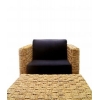|
 Environmental design is gradually becoming a trend. Therefore, it is now possible to find both green furniture and the most enterprising design products made from recycling material. Armchairs are made from discarded bicycles, people take showers inside old telephone booths, and they can sit on stools made from old tin cans. All without compromising style.
Environmental design is gradually becoming a trend. Therefore, it is now possible to find both green furniture and the most enterprising design products made from recycling material. Armchairs are made from discarded bicycles, people take showers inside old telephone booths, and they can sit on stools made from old tin cans. All without compromising style.
The marketing departments of European companies invented a special name
for such products. They call it ethical lifestyle. The use of green
furniture is related to ethical criteria. Buyers however, would not
abandon a good life and good taste. The advocates of a "lifestyle of
health and sustainability" are not indifferent to global problems. For
example, in Europe such people chose coffee in bio-supermarkets, which
are bought from poor countries without exploitation. In the evenings,
they relax on a comfortable eco-sofa or on Mosspink cushions made by
the designer Kati Meyer-Brühl. This sofa is perfectly suited for a
stylish living room with its organically round but not extravagant
form. Yet it is made from natural materials and contains almost no
harmful substances. It combines wood from a company committed to
sustainable development (development oriented to judicious and
long-term use of natural resources), natural fibres, and recycled parts
from the factory for producing waste. Mosspink is available in green,
pink, white and natural colors.
Etel Interiores, a Brazilian company
also produces its furniture and home accessories at the woodworking
factories oriented to sustainable development. Famous Brazilian
designers such as Etel Carmona, Jorge Zalszupin and Branco & Preto
architectural group, manufacture the products of the company manually.
The rare breeds of woods are obtained only from those Brazilian forests
in which the principle of sustainable development is implemented and
which have the Forest Stewardship Council international certificate.
Moreover, Etel Interior supports the restoration of Brazilian forests
with native species of trees. All of this ecological reasoning leads to
the fact that the prices of the company's products are not the
cheapest: a classical ordinary Duas Cores sofa table of 1952 designed
by Branco & Preto costs 1,700 euros, and a wooden vase costs not
less than 310 euros. The sofa is used for relaxation in Indonesia. The
furniture made from palm rattan also looks beautiful! This has been
proven by designers from Schütz Flechtwerk Company that produces wicker
furniture. They created a sofa for relaxation Whale. It was made
completely from dark brown rattan. Nevertheless, this sofa is not like
ugly rattan furniture which is usually sold at cheap furniture shops.
Like all the other products from Schütz Flechtwerk, it is handmade from
rattan, which is grown in Indonesia under a specially designed
environmental project.
Many experts predict that the demand for eco-furniture in the coming years will increase. The
manufacture of raw materials for sustainable development, recycling
materials and green production processes that do not use harmful
substances are enjoying increasing popularity. But, how do you know
that the furniture is really green? Names like "natural furniture" or
"biofurniture" are telling. If there is a Forest Stewardship Council
(FSC) stamp on a tree, then one can be sure that it was naturally
established without continuous cutting and pesticides. However,
certified furniture does not necessarily mean it is environmentally
friendly in all aspects. For example, if a certified furniture is
shipped from Brazil, a long-distance shipping means there are
significant carbon dioxide emissions. Therefore, some manufacturers
prefer to trade locally. For example, the company harvests trees by
cutting them down in suburban forests with an FSC certificate and then
sells the furniture made from the wood in the nearest market. Furniture
from processed materials is also suitable for a green lifestyle.
Although the raw materials are often conventionally harvested without
consideration to the environment, they are at least not found in
dumpsites and thus do not pollute the environment.
An excellent alternative product is to restore and resell old and valuable furniture. Unique products from garbage: Richard
Little, a British designer, converts discarded plastic into unique
sitting furniture. RD4 chairs consisting of solid plastic braids are
completely made from recycled plastic wastes. Each of the chairs are
available singly, each is unique, and they come in different colors.
Old sweaters and skirts from your closet can also be turned into
furniture. The Droog Rag Chair Company produces very beautiful and
comfortable chairs from old clothes. And even some glass vases in our
homes are handmade Karpos vases produced by Charles Delano, an American
designer,. They are made from 100% recycled glass. Tin cans that once
contained olives or other foods are converted into children's toy
kitchens or soft ottomans at the Rafinesse and Tristesse firms, a Swiss
company. Each ottoman is unique and the design depends on the available
materials. If it is possible to sit on an olive can, then you can take
a shower inside a telephone booth. One can indeed take a shower every
day inside the Re(tro) Shower booth made by the German company Lab 612,
the necessary plumbing is installed in the telephone booth.
Unfortunately, this item is available only in limited quantities.
Serial production has not yet been planned
|